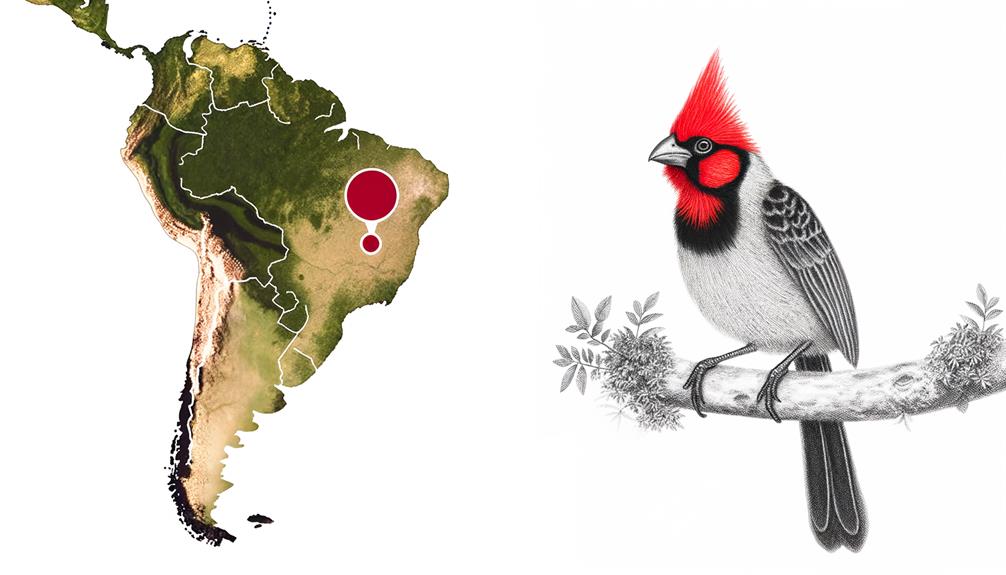Where Do Red Crested Cardinals Live? A Comprehensive Guide
You’ll find Red Crested Cardinals mainly in South America, starting from Bolivia stretching down to Argentina. They’re adapted to thrive in sub-tropical or tropical dry shrubland and degraded former forests.
Remarkably, these birds make their homes in the sunny climes of Hawaii too! Spot them easily in parks, gardens, and coastal areas thanks to their vibrant red crests. Cardinals are non-migratory, preferring stability in their selected habitats.
Climate greatly shapes their distribution and survival. So, if you’re curious about what influences their habitat and migration choices, there’s much more to discover about these fascinating birds.

Key Takeaways
- Red Crested Cardinals originate from South America, particularly regions from Bolivia to Argentina.
- They primarily inhabit sub-tropical or tropical dry shrubland and degraded former forests.
- These birds flourish in semi-open environments such as savannas, shrublands, and near water bodies in South America.
- Despite not being native, Red Crested Cardinals have successfully adapted to the ecosystem of Hawaii, often found in parks, gardens, and coastal regions.
- They prefer lower altitudes with milder climates, and their habitat choices are influenced by temperature range and precipitation levels.
Red-Crested Cardinals: Habitat and Geographic Distribution
| Aspect | Details |
|---|---|
| Native Habitat | Red-crested cardinals are native to South America, particularly in Argentina, Brazil, Bolivia, and Paraguay. |
| Introduced Regions | These cardinals have been introduced to Hawaii, where they thrive in both urban and rural areas. |
| Preferred Environment | They prefer open woodlands, shrublands, grasslands, and areas near water sources. |
| Urban Adaptation | In introduced regions like Hawaii, they are commonly found in gardens, parks, and urban settings. |
| Altitude Range | Red-crested cardinals can live in both lowland areas and higher altitudes, up to 1,000 meters. |
Origins of Red Crested Cardinals

Where do Red Crested Cardinals originate from, you might ask? Well, these striking birds hail from South America, primarily in regions stretching from Bolivia to Argentina. They’re not just random wanderers, you see. These birds have a specific range, and they’ve chosen the southern part of the continent as their home.
The climate, vegetation, and abundance of food sources in these areas make them an ideal place for these birds. The diversity of their origin locations gives them a unique genetic makeup, contributing to their vibrant red crest and striking grey body.
Primary Habitats of Cardinals
You might wonder where these vibrant birds choose to nest and thrive; well, primarily, Red Crested Cardinals inhabit subtropical or tropical dry shrubland and heavily degraded former forest. They’ve adapted to these harsh conditions, exhibiting a resilience that speaks to their survival skills.
These birds prefer open areas with a mix of trees, shrubs, and grasses, giving them ample space to fly and hunt for food. They’re not fussy about the quality of their environment, often choosing degraded habitats that other species avoid.
They nest in the lower level of the vegetation, usually in shrubs or low trees, where they build a cup-shaped nest from twigs, grass, and leaves. Their adaptability to various harsh conditions showcases their versatility and resilience.
Cardinals in South America

While they’re known for their adaptability, it’s in the diverse landscapes of South America that Red Crested Cardinals truly flourish. You’ll find these stunning birds thriving in semi-open environments, especially in savannas and shrublands. They prefer areas near water, such as river edges and marshes, where they can feed on a varied diet of seeds, fruits, and insects. Their red crests, a distinctive feature, are a mesmerizing sight against the lush greenery.
Contrary to what you might assume, these Cardinals aren’t migratory. They prefer to remain in their chosen habitats, demonstrating their fondness for stability. Freedom for these birds lies in their ability to adapt and make a home in the diverse South American ecosystems. This adaptability is key to their survival and success.
Red Crested Cardinals in Hawaii
Despite their South American origins, Red Crested Cardinals have taken flight to Hawaiian shores, adapting impressively to the island’s eco-system.
It’s noteworthy that these birds aren’t indigenous to Hawaii, yet they’ve become a common sight. You’ll find them thriving in parks, gardens, and coastal regions, their striking red crests creating a vibrant contrast against the tropical backdrop.
They’ve adapted well to urban areas, showing an impressive resilience despite the human-induced changes to their environment. It’s fascinating how these cardinals have carved out a niche for themselves in the diverse Hawaiian eco-system.
However, it’s important to remember that they’re non-native species; their impact on local fauna is still a topic of ongoing research.
Influence of Climate on Habitat

The climate greatly influences the habitat preferences of the Red Crested Cardinals, dictating their distribution and survival in different regions. They’re not just random dwellers; they’re climate-conscious. Their choices depend on several climate-related factors:
- Temperature range: Cardinals prefer moderate temperatures, avoiding extreme cold or heat.
- Precipitation: High rainfall areas favor the growth of vegetation, providing food and shelter.
- Seasonality: They migrate seasonally, seeking warmer regions during cold months.
- Altitude: Lower altitudes with milder climates are preferred.
Conclusion
You’ve journeyed from the native lands of South America to the tropical paradise of Hawaii, tracing the flight path of the striking Red Crested Cardinal.
Climate plays a significant role in shaping their habitats. So, whether you’re a bird watcher or just an admirer of nature’s beauty, remember, ‘a bird in the hand is worth two in the bush’.
Protect and respect their habitats, because their survival and the vibrancy they add to our world truly is priceless.






